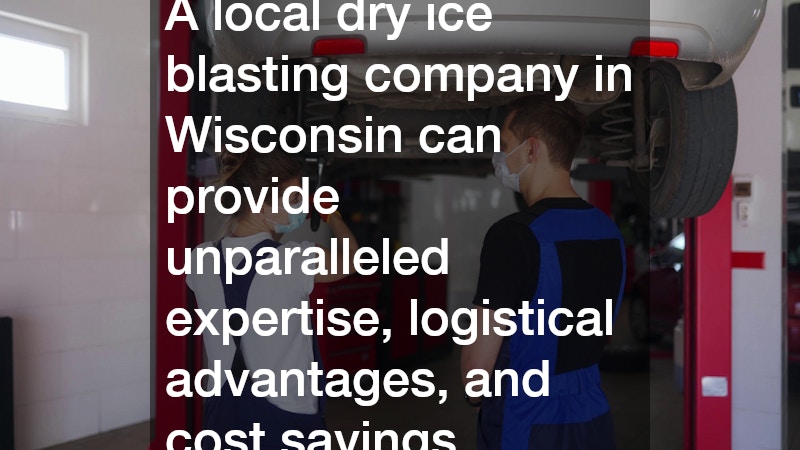Maintaining a clean and efficient automotive shop is crucial for ensuring optimal performance and compliance with standards. In a competitive industry, where every detail counts, achieving and maintaining the highest level of cleanliness can set your shop apart. Introducing dry ice blasting—a revolutionary cleaning solution that is making waves in the automotive sector, especially for shops nestled in the dynamic economy of Wisconsin.
Dry ice blasting uses solid carbon dioxide pellets accelerated at high speeds to clean surfaces. Unlike traditional cleaning methods that rely on chemicals or abrasive materials, dry ice blasting offers a non-abrasive, residue-free cleaning solution, perfect for the sensitive components and surfaces found in automotive shops.
The advantages of dry ice blasting are manifold, encompassing efficiency, safety, and effectiveness. In this article, we delve into why automotive shops can significantly benefit from engaging a local dry ice blasting company in Wisconsin, emphasizing unparalleled expertise, logistical advantages, and cost-effectiveness.
What is Dry Ice Blasting and How Does It Benefit My Shop?
Explanation of Dry Ice Blasting
Dry ice blasting is an advanced cleaning method that uses compressed air to propel dry ice pellets at high speeds onto a surface. These dry ice pellets subliminate upon impact, transitioning from solid to gas, which results in a powerful cleaning effect without leaving any secondary waste. This method is known for its gentle yet thorough cleaning capabilities.
Unlike pressure washing or sandblasting, dry ice blasting does not rely on water or abrasive materials, making it ideal for delicate machinery and electronics often found in automotive shops. The absence of secondary waste from dry ice—since it sublimates into carbon dioxide gas—also contributes to its environmentally friendly profile.
Another distinct feature of dry ice blasting is its role in reducing downtime. By cutting cleaning time significantly compared to manual cleaning methods, automotive shops can return to operations faster, enhancing overall productivity.
Advantages for Automotive Shops
For automotive shops, efficiency is key, and dry ice blasting delivers this in spades. The technique thoroughly cleans engines, transmissions, and other components without disassembly, thus minimizing the risk of damage and saving time. Additionally, it allows for cleaning in difficult-to-reach areas, ensuring comprehensive upkeep that manual cleaning might miss.
Beyond efficiency, dry ice blasting is highly effective as it removes grease, adhesives, and other tough residues effortlessly. This ensures that critical parts of vehicles maintain their performance and longevity. Moreover, the non-abrasive nature of dry ice blasting means that surfaces like paint and delicate finishes remain unharmed.
Safety is another paramount advantage. Since dry ice is non-toxic and non-flammable, it reduces risks associated with chemical cleaning agents. By choosing dry ice blasting, automotive shops prioritize the safety of their employees and the integrity of their vehicles and equipment.
Cost Comparison with Other Cleaning Methods
When comparing dry ice blasting to traditional cleaning methods, the initial cost might seem comparable. However, the true cost-effectiveness emerges when considering the reduced labor time, equipment wear and tear, and minimal downtime that dry ice blasting offers. By efficiently cleaning without disassembling parts, significant savings are achieved in labor and operational costs.
Traditional methods often require additional cleaning steps to remove secondary waste, increasing both the time and costs involved in the cleaning process. In contrast, dry ice blasting requires no further cleanup, as it leaves no residue, thereby cutting down on total labor costs and enhancing shop efficiency.
Additionally, dry ice blasting can potentially boost revenue as it extends equipment lifespan, reduces repair frequency, and allows for quicker project turnover. These benefits contribute to long-term financial health, making it a sound investment for any automotive shop.
Long-Term Maintenance Benefits
The long-term maintenance benefits of dry ice blasting manifest in well-maintained equipment that requires fewer repairs and replacements. Regular use of this method can keep machinery in optimal condition, preventing issues such as rust, corrosion, and mechanical failure, which are costly to resolve.
By preserving the integrity and functionality of automotive tools and machinery, dry ice blasting minimizes the need for expensive parts replacements. This proactive maintenance approach ensures that your shop’s equipment operates at peak performance, reducing the likelihood of unexpected breakdowns.
Furthermore, the sustainability aspect of dry ice blasting contributes to reduced environmental impact and aligns with increasing consumer demand for eco-friendly practices. This alignment with sustainable operations can enhance your shop’s reputation, attracting environmentally conscious customers and potentially expanding your client base.
Conclusion
In summary, dry ice blasting offers unparalleled advantages for automotive shops in Wisconsin. Its efficient, effective, and safe cleaning capabilities can significantly enhance operational productivity while reducing costs associated with outdated cleaning methods. The choice to work with a local Wisconsin-based company brings additional benefits of compliance, expertise, and rapid service, all contributing to a competitive edge in the automotive industry.
By investing in dry ice blasting, automotive shops can enjoy immediate performance improvements and long-term financial savings. This approach not only maintains high standards of cleanliness but also promotes the longevity of machinery and equipment, ensuring a thriving, eco-friendly business for years to come.
Ultimately, integrating dry ice blasting into your regular maintenance routine is a strategic move that promises to enhance your shop’s efficiency, customer satisfaction, and bottom line, establishing a benchmark for excellence within the industry.
